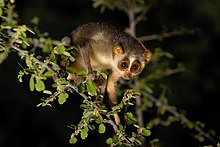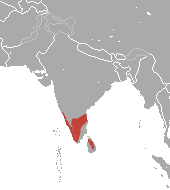Gray Slender Loris
| Gray slender loris | |
|---|---|
 |
|
| Scientific classification | |
| Kingdom: | Animalia |
| Phylum: | Chordata |
| Class: | Mammalia |
| Order: | Primates |
| Family: | Lorisidae |
| Genus: | Loris |
| Species: | L. lydekkerianus |
| Binomial name | |
|
Loris lydekkerianus Cabrera, 1908 |
|
| Subspecies | |
|
L. l. lydekkerianus (Cabrera, 1908) |
|
 |
|
| Gray slender loris range | |
L. l. lydekkerianus (Cabrera, 1908)
L. l. malabaricus (Wroughton, 1917)
L. l. nordicus (Osman Hill, 1933)
L. l. grandis (Osman Hill and Phillips, 1932)
L. l. nycticeboides (Osman Hill, 1942)
The gray slender loris (Loris lydekkerianus) is a species of primate in the family Loridae. It is found in India and Sri Lanka. Its natural habitats are subtropical or tropical dry forests and subtropical or tropical moist lowland forests. It is threatened by habitat loss. The species was previously considered as Loris tardigradus lydekkerianus but Loris tardigradus is now a separate species found in Sri Lanka. This species has been divided into several geographically separated subspecies.
The Indian subspecies include:
The Sri Lankan subspecies include:
In Sri Lankan subspecies, Loris lydekkerianus grandis has short ears, and a heart-shaped face. Basal hairs of the vent of Loris lydekkerianus grandis are black and whereas those of Loris lydekkerianus nordicus are white in colour.
Despite the slew of studies on their behaviour and ecology in the last decade, gray slender lorises still remain among the least known of all primate species. Like other lorises, they are nocturnal and emerge from their roost cavities only at dusk. They are mainly insectivorous. In southern India, the nominate race is often found in acacia and tamarind dominated forests or scrubs near cultivations. Males hold larger home ranges than females. They are usually solitary while foraging, and it is rare for them to be seen in pairs or groups. However they may roost in groups of up to 7 that include young of the recent and older litters. Adult males and females have individual home ranges and sleeping group associations are usually composed of a female and her offspring. Communicate with a range of vocalisations and also use urine and scent marking. Also, olfaction and visual signaling at a distance of at least 20m. Lorises interact throughout the night and sleep in groups during the daytime. Females with exclusive home ranges, rarely interact with other females except mothers and daughters. Females are more affiliated with males that are in the same sleeping area. Males tend to be more aggressive to other males that are not associated with their sleeping area. However, there is positive interaction with males that are within the sleeping area. The males also tend to infants that are in the sleeping area and sleeping arrangements are the only social behaviour Lorises take part in. These animals are somehow related to the bushbabies found in Africa. Their relatives, slow loris, live in northeastern India
...
Wikipedia

